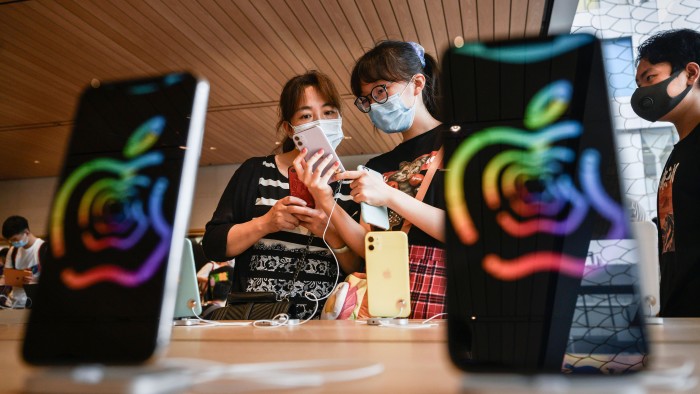Why China ‘de-risking’ brings its own business risks

Roula Khalaf, Editor of the FT, selects her favourite stories in this weekly newsletter.
In this new era of “de-risking”, with each of the G7 group of leading wealthy nations committed to lessening their reliance on China, business leaders need to develop new ways to manage their supply chains.
At a time of escalating geopolitical tensions with China, companies have sought to reduce their exposure. In 2021, Yahoo and LinkedIn announced plans to withdraw from the country and IBM shuttered its China Research Laboratory after a quarter of a century. US foreign direct investment in the country fell from a peak of $20.9bn in 2008 to an 18-year low of $8.2bn in 2022.
This exodus of American investors signals a definitive shift in global supply chains. Many US companies are “friend-shoring”: moving supply chains to political or economic allies such as India, Thailand and Vietnam. In 2022, Dell said it would move at least 20 per cent of laptop production to Vietnam. In June, Apple announced plans to shift 18 per cent of its global iPhone production to India.
At the same time, businesses are increasing their sourcing from “nearshoring” countries such as Mexico and Canada to take advantage of the USMCA free trade agreement. In July, HP said it would move production of millions of consumer and commercial laptops to Mexico.
De-risking from China through friend-shoring or nearshoring can improve supply chain resilience, but it is not risk-free. First, it may trigger risks including retaliation that impedes future US economic growth. In May, Beijing imposed a ban on Chinese operators purchasing chips from the US chipmaker Micron Technology, which derives more than one-tenth of its $31bn annual sales from the country.
Shares in Apple — which derives one-fifth of its sales from China — fell by about 6 per cent in early September after reports that the country had banned officials at central government agencies from using iPhones. Ten stocks in the S&P 500, including Qualcomm, Monolithic Power and Texas Instruments, received more than a quarter of their annual revenue from China. If retaliation persists, the tech sector will face increasing headwinds.
More than half of Chinese consumers shun US goods, according to a recent survey. With a few notable exceptions, such as Tesla’s electric vehicles and Apple’s devices, sales of many prominent brands have been declining in China since the trade war began in 2018. GM’s market share, including its joint ventures, fell from roughly 15 per cent in 2015 to below 10 per cent in 2022. To counteract the market risks, US companies must devise strategies to tap into new markets with promising growth potential.
De-risking from China by diversifying suppliers across multiple countries can also amplify operational risks by increasing the complexity and lack of transparency in global supply chains. According to a 2021 McKinsey survey, just 2 per cent of companies reported visibility beyond their second-tier suppliers — those who provide materials and parts to their direct suppliers.
This opacity makes for difficult communication and co-ordination across suppliers in different countries, adding complexity in consistency of quality and timely delivery. For example, Boeing suffered multiple setbacks in the development of its 787 aircraft. Companies should adhere to W Edwards Deming’s quality management principles, simplifying supply chains and enhancing transparency.
The lack of supply chain traceability can inadvertently cause difficulties for suppliers. For example, South Korea’s SK Hynix ceased shipping chips to Huawei after the US imposed a ban on exporting advanced chips to China. The company has been scrutinising its supply chain to understand how its chips ended up inside Huawei’s Mate 60 Pro phone.
Conversely, the US Uyghur Forced Labor Protection Act, which came into effect in June 2022, aims to prevent goods made in China from entering US markets. But forensic checks by customs officials on 37 imported Chinese garments last May showed 10 samples came from the Xinjiang region.

While de-risking the interconnected trade relationships of the US and China is not easy, the difficulties are not insurmountable. For example, after a worldwide recall of more than 19mn unsafe toys tainted with lead paint in 2007, Mattel gradually shifted production from China to Mexico, Malaysia and Vietnam. Its plant in Nuevo Leon, Mexico, is now the company’s largest worldwide.
Government support can play a pivotal role in mitigation. For instance, the $52.7bn US Chips Act subsidies can help incentivise companies such as Intel to reshore their semiconductor supply chains.
To facilitate overseas sales, the UK joined the Comprehensive and Progressive Agreement for Trans-Pacific Partnership (CPTPP) in July, expanding its free trade relationships with 11 Pacific nations. Similarly, US president Joe Biden initiated the Indo-Pacific Economic Framework in 2022 with 13 other nations, including India, Japan, South Korea and Vietnam, to streamline trade negotiations.
More such international alliances are crucial to reduce the risks of de-risking.
Christopher S Tang is UCLA distinguished professor and the Edward W Carter Chair in business administration. He is senior associate dean of global initiatives, and faculty director of the Center for Global Management at the UCLA Anderson School of Management

Comments